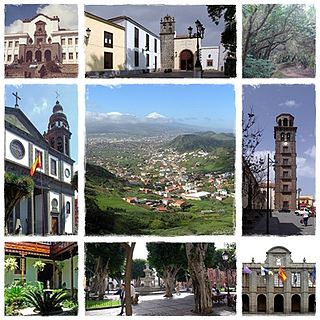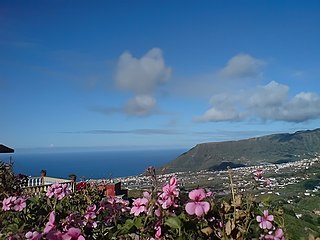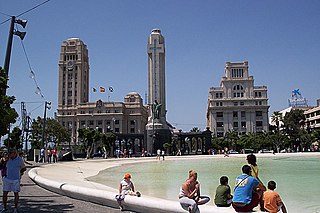
The Canary Islands, also known informally as the Canaries, are a Spanish autonomous community and archipelago in Macaronesia in the Atlantic Ocean. At their closest point to the African mainland, they are 100 kilometres west of Morocco and the Western Sahara. They are the southernmost of the autonomous communities of Spain. The islands have a population of 2.2 million people and are the most populous special territory of the European Union.

La Gomera is one of Spain's Canary Islands, in the Atlantic Ocean off the coast of Africa. With an area of 370.03 km2 (142.87 sq mi), it is the third-smallest of the archipelago's eight main islands. It belongs to the province of Santa Cruz de Tenerife. La Gomera is the third least populous of the eight main Canary Islands, with 22,361 inhabitants at the start of 2023. Its capital is San Sebastián de La Gomera, where the cabildo insular is located.

Tenerife is the largest and most populous island of the Canary Islands. It is home to 42.9% of the total population of the archipelago. With a land area of 2,034.38 square kilometres (785.48 sq mi) and a population of 948,815 inhabitants as of January 2023, it is also the most populous island of Spain and of Macaronesia.

Santa Cruz de Tenerife, commonly abbreviated as Santa Cruz, is a city, the capital of the island of Tenerife, Province of Santa Cruz de Tenerife, and one of the capitals of the Canary Islands, along with Las Palmas. Santa Cruz has a population of 206,593 (2013) within its administrative limits. The urban zone of Santa Cruz extends beyond the city limits with a population of 507,306 and 538,000 within urban area. It is the second largest city in the Canary Islands and the main city on the island of Tenerife, with nearly half of the island's population living in or around it.
San Cristóbal, Spanish for Saint Christopher, may refer to:

Teide, or Mount Teide, is a volcano on Tenerife in the Canary Islands, Spain. Its summit is the highest point in Spain and the highest point above sea level in the islands of the Atlantic. If measured from the ocean floor, its height of 7,500 m (24,600 ft) makes Teide the third-highest volcano in the world, and is described by UNESCO and NASA as Earth's third-tallest volcanic structure. Teide's elevation above sea level makes Tenerife the tenth highest island in the world.

San Cristóbal de La Laguna is a city and municipality in the northern part of the island of Tenerife in the Province of Santa Cruz de Tenerife, on the Canary Islands, Spain. The former capital of the Canary Islands, the city is the third-most populous city of the archipelago and the second-most populous city of the island. La Laguna's historical center was declared a World Heritage Site by UNESCO in 1999. La Laguna is situated alongside the city of Santa Cruz de Tenerife; thus, the two cities and municipalities form a single large urban center. Its economy is business-oriented while agriculture dominates the northeastern portion of the city. The urban area dominates the central and the southern parts.

Tegueste is a town and a municipality of the northeastern part of the island of Tenerife in the Santa Cruz de Tenerife province, on the Canary Islands, Spain. It is surrounded by the municipality of San Cristóbal de La Laguna. The town Tegueste is located 4 km northwest of San Cristóbal de La Laguna and 11 km northwest of the island capital Santa Cruz de Tenerife. Tegueste became independent from San Cristóbal de La Laguna in the 17th century.

The University of La Laguna is a public research university situated in San Cristóbal de La Laguna, on the island of Tenerife, Spain. It is the oldest university in the Canary Islands. The university has six campuses: Central, Anchieta, Guajara, Campus del Sur, Ofra and Santa Cruz de Tenerife.
The Canary Islands are an archipelago, or island chain, in the Macaronesia region of the Atlantic Ocean off the coast of North Africa. They are one of 17 autonomous communities of Spain. The demographics of the Canary Islands are concentrated in the largest islands of Tenerife and Gran Canaria.
The Canary Islands are an autonomous community of Spain. The headquarters of the Canary Islands military command is located in Santa Cruz de Tenerife, in the Palacio de la Capitanía General de Canarias. The following components of the Spanish Armed Forces are based in the Canary Islands:

The Diocese of San Cristóbal de La Laguna, also called Diocese of Tenerife or Diocese Nivariense, is a diocese located in the city of San Cristóbal de La Laguna in the Canary Islands and a suffragan in the ecclesiastical province of the Archdiocese of Sevilla in Spain. The diocese includes the islands of Tenerife, La Palma, La Gomera and El Hierro, in the province of Santa Cruz de Tenerife. The bishop of this diocese is Bernardo Álvarez Afonso.
Tourism is an essential part of the economy of the Canary Islands, a Spanish archipelago located in the Atlantic Ocean, 100 kilometres west of Morocco. Seven main islands and six islets make up the Canary Islands. They had more than 9 million foreign incoming tourists in 2007. Tourists seeking sunshine and beaches first began to visit the Canaries in large numbers in the 1960s. The Canary Islands are a leading European tourist destination with very attractive natural and cultural resources.

Fernando Estévez was a Spanish sculptor of the 18th century from La Orotava, Tenerife. He is considered one of the Canary Islands most noted sculptors.

"Bajada" is the shortened version of the Fiestas de la Bajada which is a festival which takes place in several places in the Canary Islands. Bajada is Spanish for "bringing down", and means the bringing of a patron saint's statue from its normal place in a chapel to be celebrated by the people.

The Cathedral of San Cristóbal de La Laguna or Catedral de Nuestra Señora de los Remedios is a Roman Catholic church in Tenerife, Spain. Begun in 1904 and completed in 1915, it is dedicated to the Virgin of Los Remedios. The cathedral is the mother church of the diocese, which includes the islands of Tenerife, La Palma, La Gomera and El Hierro in the province of Santa Cruz de Tenerife. It is therefore where the episcopal seat of the bishop of this diocese, currently occupied by Bishop Bernardo Álvarez Afonso. This is one of the most important churches of the Canary Islands.

Plaza de España, is the largest square in the city of Santa Cruz de Tenerife and the Canary Islands (Spain). The square is located in the centre of town, 1.4 km north of the Auditorio de Tenerife. This square is considered one of the "main squares" of the island of Tenerife, together with the Plaza del Cristo de La Laguna in San Cristóbal de La Laguna and the Plaza de la Patrona de Canarias in Candelaria. It hosts an artificial lake fountain, a work of Swiss architects Herzog & de Meuron.
As in the rest of Spain, the majority religion in the Canary Islands is the Catholic Church. The Catholic religion has been the majority since the Conquest of the Canary Islands in the fifteenth century. This religion would largely replace the Canarian aboriginal religion through the prohibition of the latter and syncretism. According to a survey conducted in 2019, Canary Islands is the fifth autonomous community in Spain with the highest percentage of people who declare themselves to be Catholics after the Region of Murcia, Extremadura, Galicia, Aragon, and Castile and León. 76.7% of the population is Catholic.






















